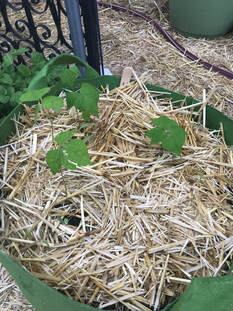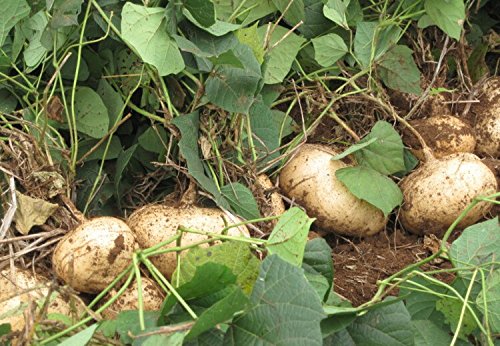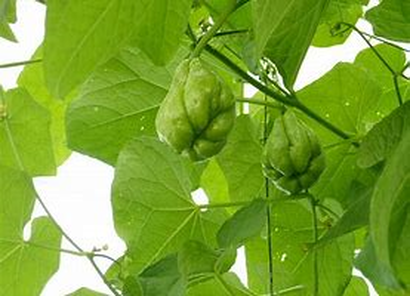Today I wanted to share a quick blog on three unique, edible plants we are growing. It is our first time in growing them.
I have had to snicker at myself as each time I have learned about a new plant I was immediately googling to see what they were about. Then the next minute I was on Amazon purchasing my new seeds.
It was then Roy (my sometimes voice of reason) would ask the most important question for our very small space...
”Uh Kim do you know where you will plant them?”
Geezzz do I have to figure everything out? Wink! Wink! So far it has worked out, but I do believe a time will come where I will have to sit on my hands.
In the hot climate down here, we wanted to find plants that could withstand the heat. We are hopeful these three varieties will pass the test and will provide us with some great produce to come.
What In The
World is Jicama?

There is hardly any fat, less than 1 percent, and low in calories. The only downfall I can see is that the skin, leaves, stems, pods and seeds should be decarded properly, as they are unsafe to eat. There are many YouTube videos on growing this root vegetable so I wanted to try. We did plant in a breathable potato bag and so far it is growing fine.
I bought a store bought Jicama to try out before I decided to plant. Make sure the skin is hard. We stored ours in a cool, dry place. From what we have read, it does not do good in the cold, but can be stored in the frig. Make sure it is stored without the possibility of moisture getting to it.
Wash and skin the Jicama before eating it. I cut mine up in my salad. You can chop, cube, slice, eat raw, or even cook Jicama. It is very versatile. It is great in stir-frys, salads, slaw, soups and goes well with most meats, vegetables or fruit.
A little Jicama sprinkled with chili powder, salt, and lime juice is one of the most enjoyable Mexican recipes to eat Jicama.
Its Chayote NOT
Coyote
It originated from Mexico and Central America. It is also known as Mirliton Squash.
Chayote is sometimes rare, but gaining popularity. It can be eaten raw or in salads. It also can be marinated with lemon or lime juice. Throw in a little Cilantro and we have a delicious snack.
The roots, leaves, and stem are edible and often eaten in salads and stir-fry's. The seeds can be roasted as well.
The Chayote grows on a vine which attach to fences, shrubs, and even trees. It grows best in a warm climate. The flowers is what will eventually become the vegetable. One plant can grow up to 300 Cayotes per year which is phenomenal. It is one plant that you can share as it appears it grows in abundance.
There is some great nutritional news concerning the Chayote. It has no cholesterol or unhealthy fats.
It actually is recommended to consume to control Cholesterol. It is a rich source of dietary fiber, Vitamin C, Phosphorus, and Potassium. The Folate is helpful for pregnant women.
It also fights free radicals in the body to fight ageing and cancer. It is definitely is low in calories. I am thinking this may be our best find yet in growing the perfect vegetable. I now have three pots with Chayote seeds planted. I cant wait to see what comes of them.
The space, the trellis, and other concerns will have to be addressed soon when the plants need to be planted. My famous line to Roy...”Don’t worry it will work out!”
The Infamous "Rat Tails" Radish

We planted the seeds right into the ground and covered with straw, watering every other day.
We did have some critters nibble on the baby leaves. I read where citrous may deter bugs. I put lemon halves into my water every day so when I am done with my drink, I place them around the base of the plant. I have to say it has worked really great to deter some insects.
The strange name may not evoke the palate per say, but it did start out with royal beginnings.
It was found in English gardens in the early 1800's and became quite a hit at the International Horticultural Exhibition. The new vegetable had an astounding growth rate over night.
Being that I am growing this plant as I write, this part of history may have been a bit exaggerated I am thinking, but who am I to say. Perhaps the variety did have a super power back then and was able to grow over night but I did not find this to be true.
These wonderful edible pods grow well in heat and produce long after the root radishes which make for a gardeners dream.
They can grow up to 4 ft. and like to be pruned so they can continue to produce well. They are best picked when small and that is when they are the crispest and have a mild radish flavor.
You can eat raw or stir fry them, and even pickle them. They are fun and enjoyable all around. Toss them in a salad; they are delish. Pods will appear between 40-50 days, with the lowest ones ripening first. Pick them when small, about pencil thick, when they are at their most pungent and crisp.
I am looking forward to their blossoms which will attract butterflies and other little insects to pollinate the garden.
Hugs,
Roy and Kimmie



 RSS Feed
RSS Feed

